Yes, Amethyst can go in water. Use fresh water to cleanse Amethyst but avoid salt water exposure.
Amethyst, a popular and beautiful gemstone, is known for its powerful healing properties and stunning purple hues. But when it comes to the interaction between amethyst and water, many questions arise. Can you bathe with amethyst jewelry? Can amethyst go in water? What about cleansing your amethyst crystal in water? Worry not, as we’ve got you covered. In this comprehensive guide, we will explore everything you need to know about amethyst and its interaction with water, including the safety of submerging your precious stone in various types of water, the effects of sun exposure, and alternative cleansing methods.
Key Takeaways
- Amethyst is water safe when proper precautions are taken.
- Fresh water is a safe and effective method for cleansing amethyst, avoiding vinegar, hydrogen peroxide etc.
- Avoid salt water exposure to preserve the stone’s vibrancy. Remove jewelry before showering or swimming.
Is Amethyst Water Safe?
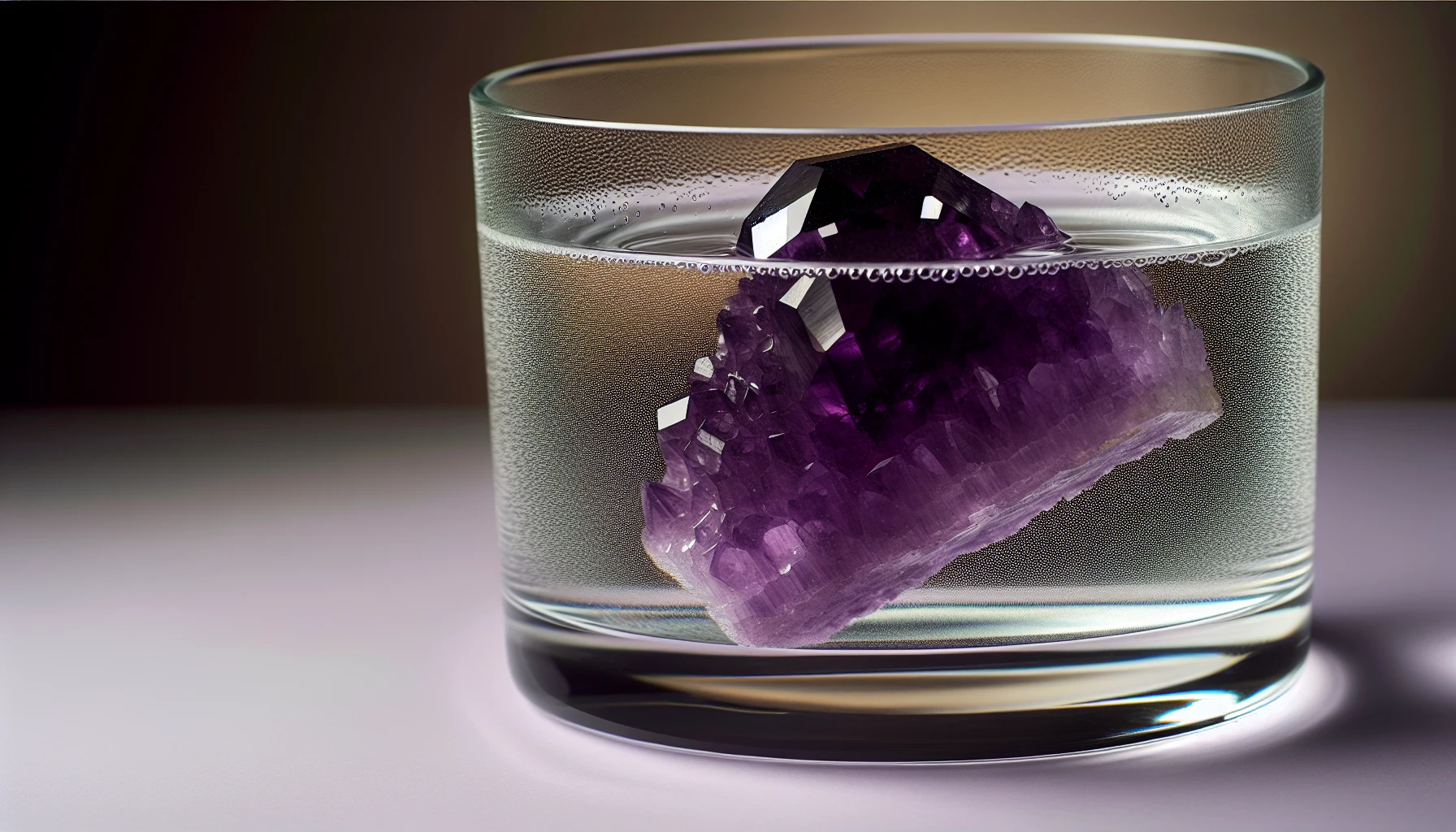
Yes, Amethyst crystals are generally safe when exposed to water. Nonetheless, certain precautions should be adhered to in order to maintain the durability and aesthetics of this precious gemstone. When putting Amethyst in water, it is advisable to avoid salt water and sudden temperature changes, as these can cause damage to the stone.
Ensuring that amethyst is thoroughly dried after cleansing with water is also of significance. To maintain the healing properties of Amethyst, allow it to air dry or gently pat dry by hand. By taking these precautions, you can cleanse and recharge your Amethyst without compromising its integrity and healing powers.
Is Amethyst and Fresh water a Safe Combination?
Cleansing Amethyst with fresh water, inclusive of tap and filtered water, is a secure and apt method. While water is generally safe for Amethyst, it is important to avoid certain types of water that may contain harmful substances. For example, water containing:
- vinegar
- hydrogen peroxide
- ammonium fluoride
- hydrofluoric acid
- alkaline solutions
is best avoided to guarantee optimal cleansing of Amethyst, which possesses a Mohs hardness scale rating of 7.
Hence, when you cleanse your Amethyst, using fresh water is recommended to sidestep any potential damage. Fresh water is not only safe for your Amethyst but also helps maintain its vibrant color and metaphysical properties for a long-lasting and powerful healing experience.
What is The Effect of Salt Water on Amethyst?
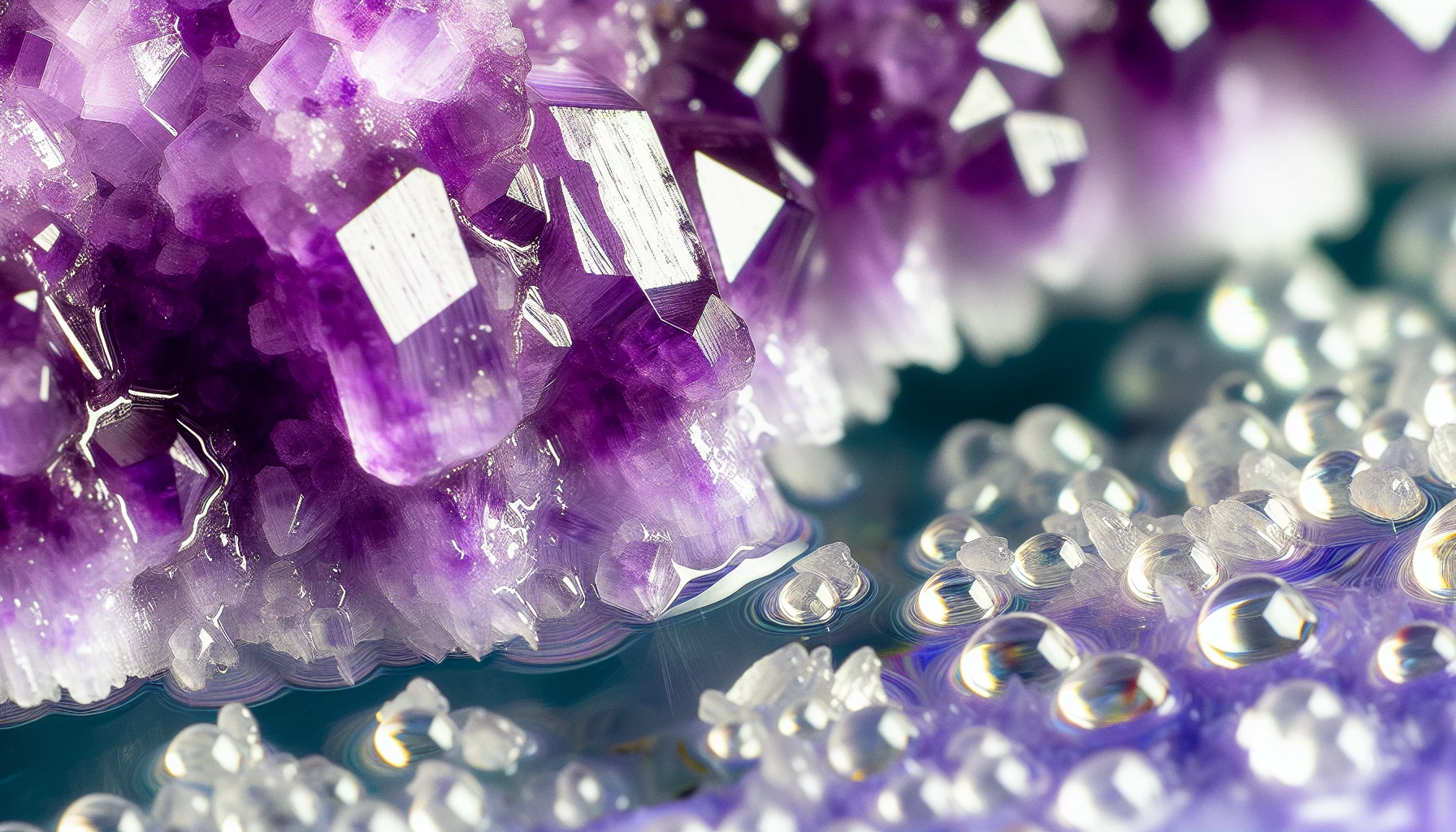
Salt water, due to its corrosive properties, can be harmful to your Amethyst crystal. Exposure to salt water may cause damage to the stone’s structure and color, so it’s crucial to avoid immersing your Amethyst in salt water. If your Amethyst does come into contact with salt water, it is recommended to rinse it thoroughly after use to remove any salt particles that may have adhered to the surface.
Avoiding extended immersions is recommended when cleansing Amethyst with ocean water. Instead, give your Amethyst a brief immersion in ocean water, followed by a rinse with regular water from top to bottom. This way, you can cleanse your Amethyst without causing any harm to its delicate structure and color.
In an Amethyst-infused bath session, using natural and crystal-friendly products is advisable to hinder any possible damage to the amethyst. Refrain from introducing any chemical cleaners or other harsh additives, such as super abrasive cleaners, chemical-based products, and even bath salts. By keeping your Amethyst away from salt water and harsh bath products, you can ensure its longevity and continued healing benefits.
How to Cleanse Amethyst with Rain and Moon Water?
Rain and moon water serve as outstanding alternatives for cleansing and recharging your Amethyst crystal. Moon water is purified water that has been energized by the energy of a full moon. To create moon water, simply leave a container of clean water outside during a full moon’s cycle. Utilizing moon water to cleanse and recharge Amethyst can amplify the energetic advantages of both the water and the crystal, assisting in:
- Balancing energies
- Enhancing communication
- Providing mental clarity
- Increasing spiritual awareness
However, it is advisable to avoid creating moon water during an eclipse.
Rainwater is another effective option for cleansing your Amethyst, as well as other cleansing crystals. Collect rainwater in a clean container and use it to cleanse your crystal. Like moon water, rainwater is charged with natural energy that can help remove negative energy from your Amethyst and recharge its healing properties.
With these alternative water sources, you can effectively cleanse and recharge your Amethyst while preserving its natural beauty and power.
Warm Water and Amethyst: Precautions and Best Practices
Though cleaning Amethyst with warm water is safe, a few precautions are worth considering. It is best to avoid hot water and sudden temperature changes as they can cause your Amethyst to crack. Instead, opt for warm water when cleaning your Amethyst to ensure its structure remains intact and its healing properties unharmed.
You can clean your Amethyst by following these steps:
- Immerse it in warm, soapy water.
- Gently scrub it with a soft cloth or brush.
- Rinse the crystal thoroughly.
- Pat it dry or allow it to air dry naturally.
By following these best practices, you can maintain the beauty and healing powers of your Amethyst crystal without causing any damage.
Amethyst in Bathwater: Enhancing Your Relaxation
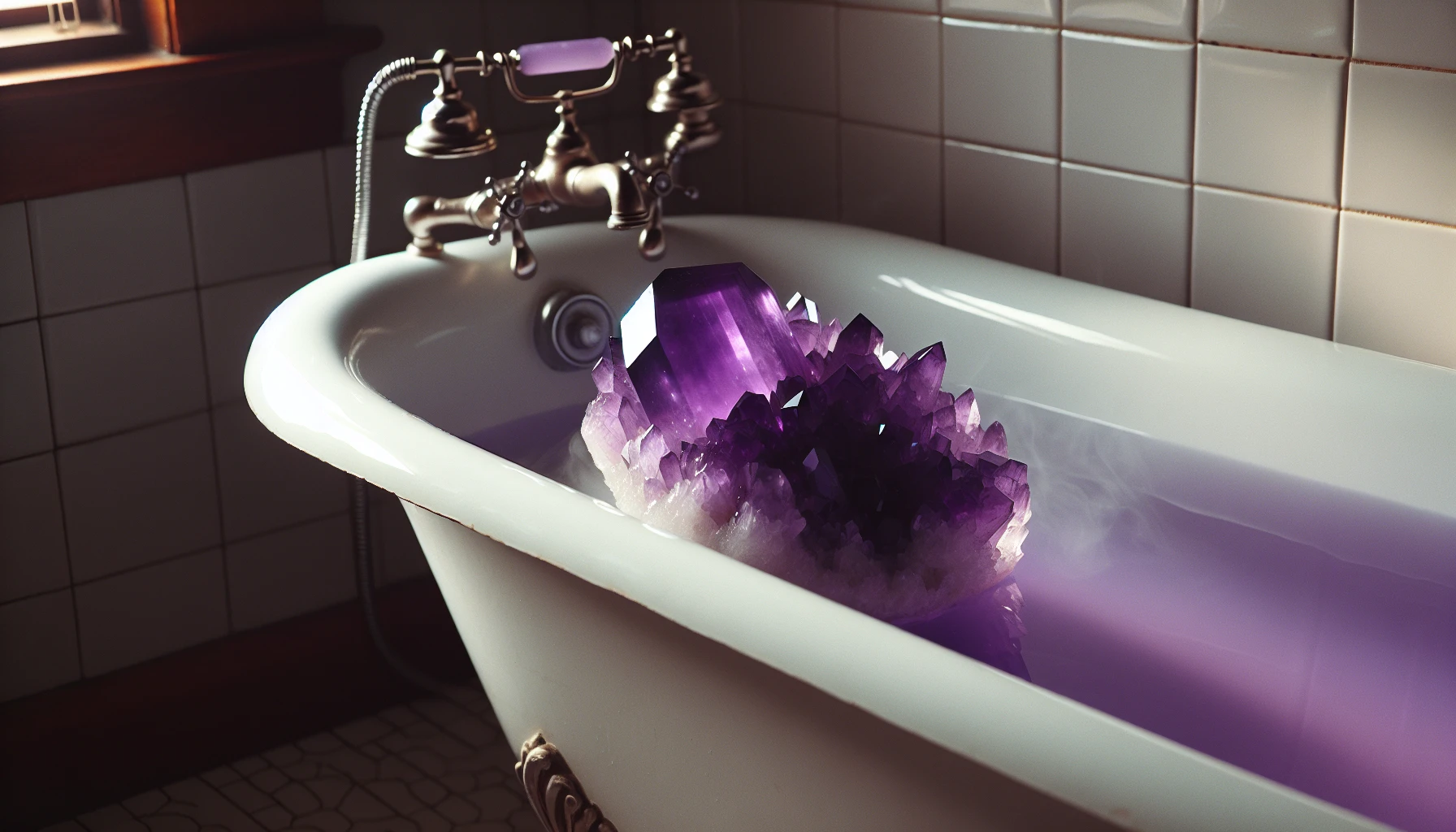
Amethyst serves as a beautiful and therapeutic addition to your bathwater, offering a soothing and calming experience. However, it’s essential to take proper care of your Amethyst when using it in this manner. To protect your amethyst from potential damage, use natural and crystal-friendly products while bathing. Avoid introducing chemical cleaners, harsh additives, or abrasive materials, such as bath salts, to your bathwater when using amethyst.
By following these precautions, you can enjoy the relaxation and healing benefits of amethyst in your bath water without causing any harm to your precious stone. With the right care, you can elevate your bathing experience and enhance your overall well-being with the power of amethyst and the use of bath bombs.
Swimming and Showering with Amethyst Jewelry
It might not be the best idea to wear Amethyst jewelry while swimming or showering. The potential exposure to chemicals, such as chlorine, and harsh water conditions can cause damage to your amethyst. Chlorine, in particular, can cause damage to the stone, leading to discoloration and other forms of damage.
If you want to keep your amethyst jewelry looking its best, it is advisable to remove it before swimming or showering. By taking these precautions, you can protect your Amethyst jewelry and ensure it remains a beautiful and powerful healing tool for years to come.
Sun Exposure and Amethyst: What You Need to Know
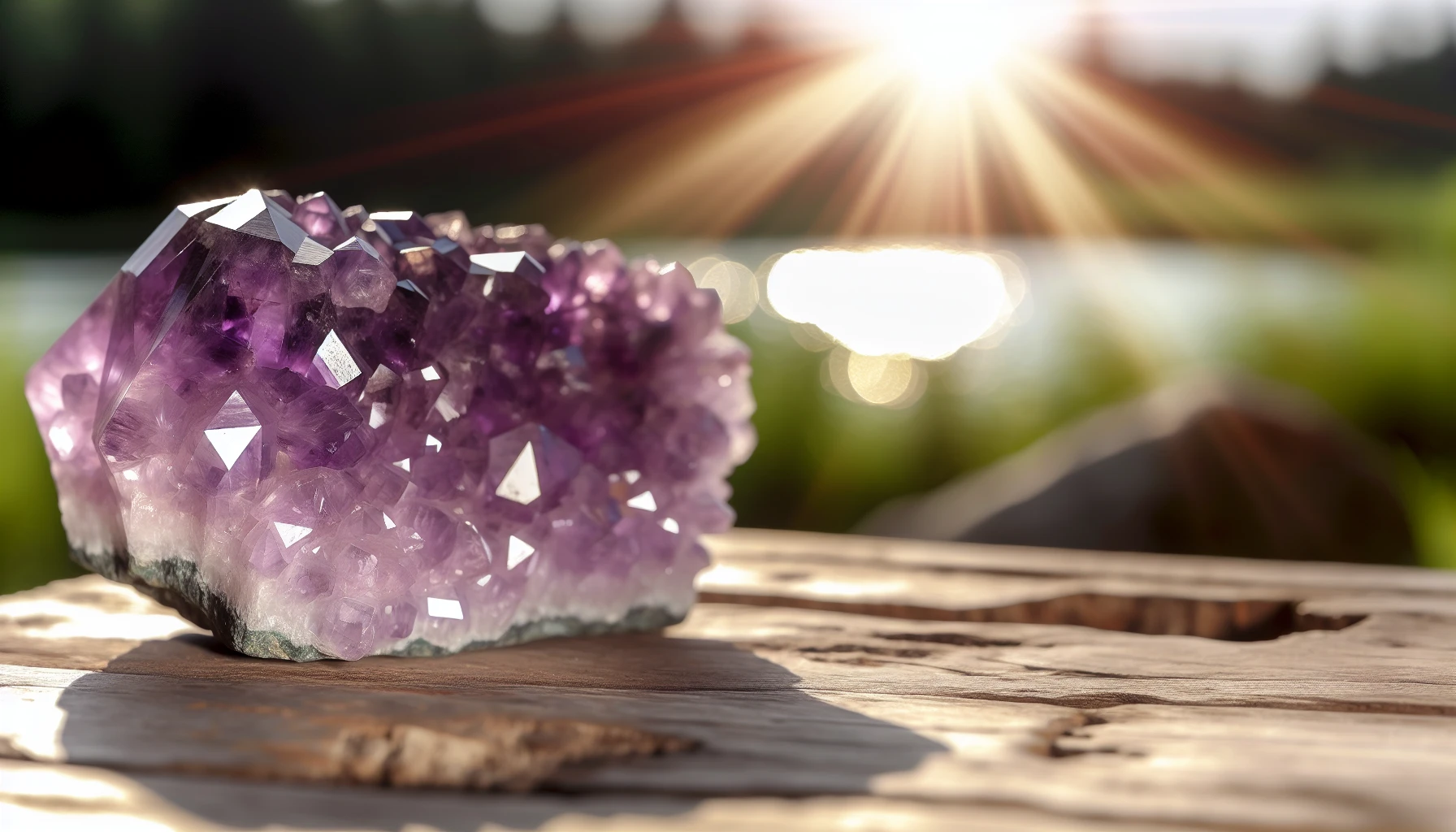
Although Amethyst is a robust and resilient gemstone, it is not resistant to the impacts of sun exposure. Prolonged exposure to sunlight can cause the color of Amethyst to fade over time. The iron color centers within the amethyst crystal can be caused to realign due to sunlight, resulting in a fading of the stone’s color. To retain its vibrant color and healing properties, it is advisable to avoid direct sunlight and store your Amethyst in a cool, dark place.
By protecting your Amethyst from prolonged sun exposure, you can ensure that its color remains vibrant and its healing powers intact. Remember that prevention is key, and taking the necessary precautions can help keep your Amethyst looking its best for years to come.
What are Alternative Cleansing Methods for Amethyst?
Several alternative cleansing methods for your Amethyst are available if you’re seeking alternatives. Smudging, for instance, involves using sage or smudge sticks to cleanse Amethyst by allowing the smoke to surround the crystal for a few minutes, visualizing the negative energy being released. For a more thorough cleansing, the Amethyst can be left in the smoke for several hours.
Another alternative method for cleansing Amethyst is burying it in the earth. Here’s how:
- Bury your Amethyst in a pot of soil or sand.
- Allow it to remain in the ground for a period of days or weeks, depending on the size of the stone.
- When ready to retrieve it, excavate and rinse with water.
Other techniques include using sound or visualization techniques, such as chanting, singing, or playing music in proximity to the stone, or envisioning the stone filled with light or energy. By exploring these alternative cleansing methods, you can maintain the cleanliness and vibrancy of your Amethyst without using traditional water-based methods.
What are the Benefits of Amethyst-Infused Water?
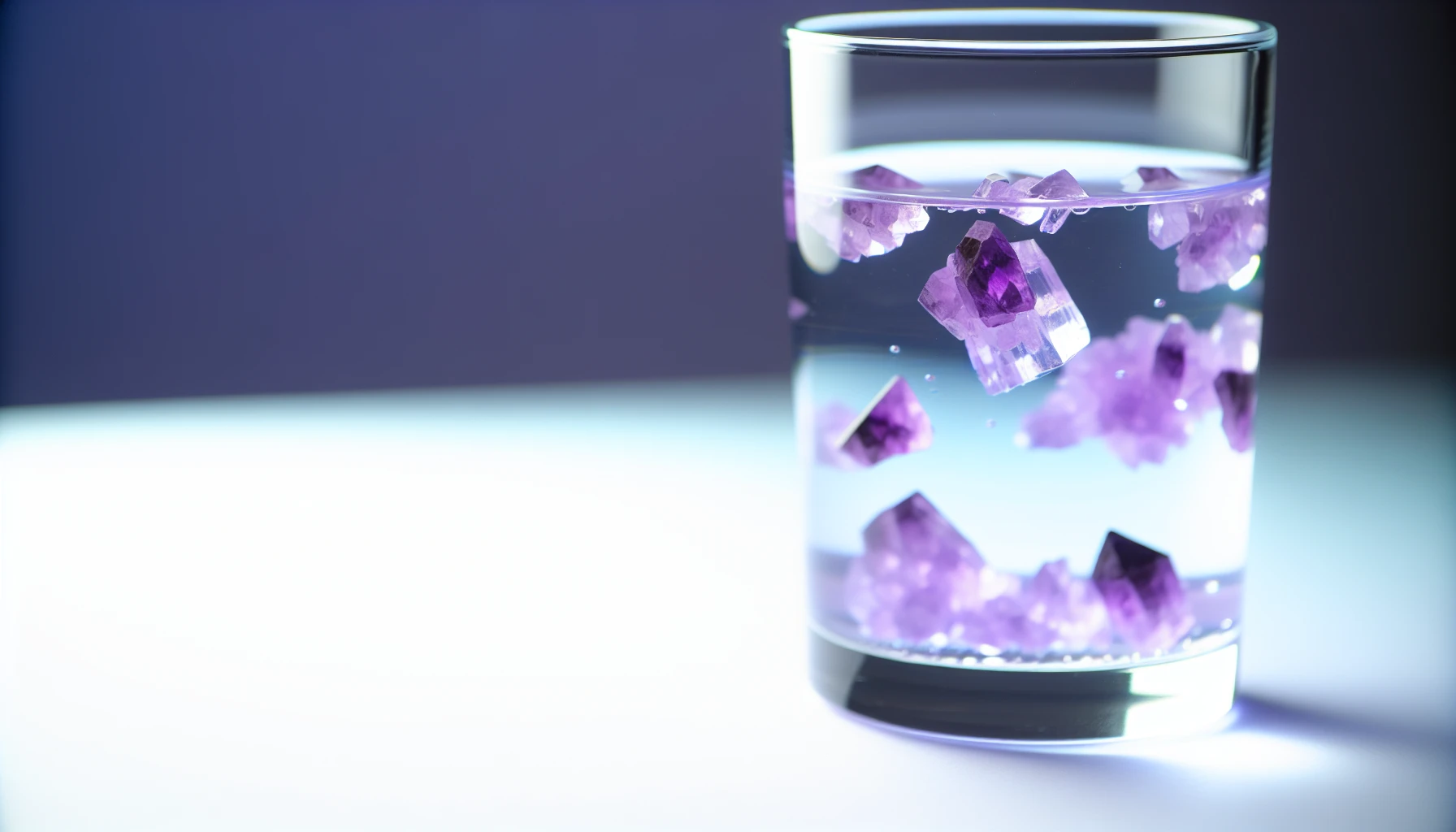
Amethyst-infused water, being water imbued with Amethyst’s healing energy, provides various benefits to its consumers. It is generally safe to drink Amethyst-infused water, which may offer benefits such as toxin removal, hormone regulation, and enhanced healing energy.
Some reported health benefits of consuming Amethyst-infused water include:
- Aiding relaxation
- Reducing stress and anxiety
- Aiding better sleep
- Enhancing mood
- Improving hydration
Additionally, it is believed to have a harmonizing effect on the body, bringing balance to the endocrine system and improving overall metabolism. Though further research is required to accurately understand the effects of Amethyst on hormone regulation, many individuals have experienced its healing benefits and enjoyed the positive energy that Amethyst-infused water brings to their lives.
Know More About Your Amethyst Crystal
Amethyst is an intriguing gemstone, possessing a rich history and potent healing properties. In the following subsections, we will discuss various aspects of Amethyst care, including:
- Amethyst’s interaction with water
- Sun exposure
- Salt
- How to clean and maintain your amethyst for optimal healing benefits and beauty.
Can Amethyst Get Wet?
Yes, Amethyst can get wet. While it is generally safe for amethyst to get wet, certain precautions are important to ensure its durability and aesthetics. Here are some tips to follow:
- Avoid immersing your Amethyst in water for extended periods, as this can lead to damage.
- When cleansing your Amethyst with water, use fresh water like spring water or tap water, which are safe options for this purpose.
- It is recommended to avoid using vinegar, ammonium fluoride, hydrofluoric acid, hydrogen peroxide, or alkaline solutions when cleaning amethyst, as these substances might damage the stone.
By following these guidelines, you can ensure that your Amethyst remains safe and vibrant even when it gets wet. Remember, proper care and maintenance of your Amethyst are essential for preserving its healing properties and stunning appearance.
Can Amethyst Go In the Sun?
No, Amethyst cannot go in the sun. Despite Amethyst being a robust gemstone, it is not impervious to the effects of sun exposure. Prolonged exposure to sunlight can cause the color of Amethyst to fade over time, due to the realignment of the iron color centers within the crystal. To preserve its color and healing properties, it is advisable to limit exposure to sunlight and store your amethyst in a cool, dark place.
By protecting your Amethyst from prolonged sun exposure, you can ensure that its color remains vibrant and its healing powers stay intact. Remember that prevention is key, and taking the necessary precautions can help keep your amethyst looking its best for years to come.
Can Amethyst Go In Salt?
No, Amethyst cannot go in salt. The corrosive properties of salt can make it harmful for the crystal when your amethyst is exposed to salt or salt water. The high salt content in salt water can cause damage to the surface of the amethyst crystal, so it is not advisable to submerge Amethyst in salt water. Instead, use fresh water for cleansing and ensure that your Amethyst remains vibrant and powerful.
By avoiding salt and salt water exposure, you can protect your Amethyst and ensure its longevity and continued healing benefits. With proper care, your Amethyst will continue to bring balance and harmony to your life.
How to Clean Amethyst?
The process of cleaning your Amethyst is simple and only requires a few steps:
- Fill a bowl with warm, soapy water.
- Submerge your Amethyst in the water and let it soak for a few minutes.
- Gently scrub the crystal’s surface with a soft cloth or brush to remove any dirt or debris.
- Rinse the amethyst thoroughly under running water to remove any soap residue.
- Pat the crystal dry with a soft cloth or allow it to air dry naturally.
By following these steps, you can keep your Amethyst clean and looking its best.
It is crucial to avoid using steam cleaners for cleaning Amethyst, as the heat generated may damage the stone. By following these best practices, you can maintain the beauty and healing powers of your Amethyst crystal without causing any damage.
How to Clean an Amethyst Geode?
A gentle approach is required when cleaning an Amethyst geode. Here’s how to clean an Amethyst Geode:
- Use a soft-bristle brush, such as a paintbrush or toothbrush, to clean the geode.
- Avoid using household products such as bleach, vinegar, or any harsh chemicals.
- Opt for plain water with a bit of mild dish soap or laundry detergent for effective and safe cleaning.
After cleaning your Amethyst geode, rinse it thoroughly with water to remove any soap residue. By following these steps, you can keep your Amethyst geode looking its best and maintain its powerful healing properties.
Is Amethyst Water Soluble?
While Amethyst is not soluble in water, its prolonged exposure to water can result in its deterioration. Although Amethyst is safe to be immersed in distilled, tap, hard, and soft water without causing damage to the crystal, it is important to limit the duration of Amethyst’s exposure to water to 20-30 minutes to prevent potential damage to its structure.
By taking these precautions, you can ensure that your Amethyst remains safe and vibrant even when it comes into contact with water. Proper care and maintenance of your Amethyst are essential for preserving its healing properties and stunning appearance.
Can You Shower With Amethyst?
Due to the potential exposure to chemicals and temperature changes, showering with Amethyst jewelry is not recommended. To protect your Amethyst jewelry from potential damage, it is best to remove it before swimming or showering.
By taking these precautions, you can protect your Amethyst jewelry and ensure it remains a beautiful and powerful healing tool for years to come. Remember, proper care and maintenance are vital for preserving the beauty and healing properties of your amethyst.
Summary
In conclusion, Amethyst is a beautiful and powerful gemstone with many healing properties. Proper care and maintenance are essential to preserving its beauty and power. By understanding the interaction between Amethyst and water, you can ensure the longevity and effectiveness of your amethyst crystal. Remember to avoid salt water, limit sun exposure, and utilize alternative cleansing methods when necessary. With the proper care, your Amethyst will continue to bring balance, harmony, and healing energy into your life for years to come.
Frequently Asked Questions About Amethyst in Water
Can Amethyst go in pool water?
Amethyst jewelry should be kept away from swimming pool water as the chlorine can slowly erode the finish and polish of the gem. Protect your amethyst pieces from this element to ensure their longevity.
Can an Amethyst go in a water bottle?
Yes, an Amethyst is a quartz stone and can safely be placed in water.
What happens if Amethyst goes in water?
When Amethyst comes into contact with water, it absorbs moisture and becomes soft. It can also change colors, but returns to its original state as the water evaporates. Thus, it is important to keep the Amethyst dry in order to avoid damaging it.
Does Amethyst grow in water?
Amethyst can be found growing in water sources and is often formed over time from water carrying dissolved minerals that seep into the ground and react with existing minerals. Amethyst geodes are often formed inside of three-layered geodes or small caves under Y coordinate 70.
How can I cleanse my Amethyst using alternative methods?
You can cleanse your Amethyst using alternative methods such as smudging, burying it in the earth, or using sound or visualization techniques.